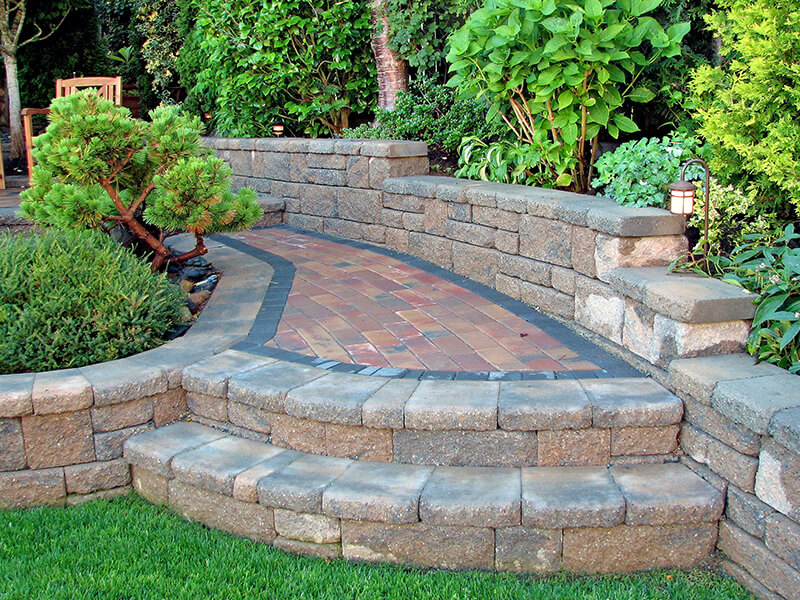Retaining walls are everywhere. From homes and schools to parks and cliff-side highways, these solid structures litter our world, creating useable plots of land while preventing landslides and soil erosion. You probably see them every day without even taking notice. What’s more, it’s likely you could benefit from getting a retaining wall yourself if you don’t already have one.
Who Needs a Retaining Wall?
Retaining walls are most necessary for people in one of the following situations:
- Your property sits on or at the bottom of a hill. Low-elevation properties are the number one candidate for retaining walls as they are more prone to soil erosion and to flooding. Without a retaining wall, mud, soil, and water can flow down into your yard and cause considerable issues for your property. In severe cases, it can even damage the foundation of your home and compromise its structural integrity. As such, a retaining wall will keep your land useable and your property safe from harm.
- You’re on uneven terrain. Even if your home doesn’t face a large hill, you may still consider a retaining wall a necessary investment. If your property slopes or dips down for example, you can install a series of retaining walls to level off your land into multiple terraced sections. It’s also a useful tactic if you live on the top of a hill, giving you tiers of flat useable land suitable for a garden, a playground, or a swimming pool.
- You want a tiered garden. Tiered gardens are a great addition to any home property. They look great, increase your property value, and can transform a drab backyard into a beautiful outdoor living space. Even if your property is not particularly uneven, you may consider getting one or more retaining walls to create your very own swanky tiered garden.
Why Should I Get a Retaining Wall?
There are plenty of reasons why a retaining wall is a great investment. Here are the main ones:
Extend useable area of land. Farmers have used retaining walls for centuries to maximize the area of tillable land at their disposal. While you may not want to grow maize any time soon, you’ll still find it useful to have a retaining build extend your useable area of land. Since they’re built by excavating the base of a hill and then levelling it off, retaining walls are a great way to create several sections of flat land that you can develop further. With a retaining wall, you’ll have more space for such investments as a swimming pool or a patio. If your backyard is just one big hill, you’ll be able to transform it into a great outdoor living area with a series of retaining walls.
Stop soil erosion. By sectioning your land into multiple plateaus, a retaining wall prevents soil from flowing downhill onto your property. And since the soil stays still, it becomes much easier to create a functional vegetable garden or an outdoor living area. In the long run, a retaining wall will help you keep your yard in optimal condition.
Prevent flooding. In addition to soil, a retaining wall can also stop water from flowing into your yard. Retaining walls are built with a section of drainage stone behind them, which prevents water from building up and instead lets it flow gradually. The result? You’ll have fewer pools of mud in your yard—and in worst-case scenarios, you’ll prevent flood damage from wreaking havoc on your property.
Add aesthetic appeal. Retaining walls don’t only serve a functional purpose. They can also be a stylish addition to your property. There’s nothing like a good-looking stone wall to transform the look of your yard and give it a cohesive landscape design. It’ll add curb appeal and can form the foundation for a great outdoor living space.
Increase property value. A stone retaining wall can increase the appeal of your property and entice homebuyers to check it out. And if you live on a hill, a well-built retaining wall indicates that your property is safe from flooding and soil erosion, in turn increasing its market value. Mitigate the risks, improve the value of your home. It’s a win-win situation for everyone.
What Type of Retaining Wall Should I Get?
Timber—Generally, timber is the least expensive building material for a retaining wall. It’s a great choice for a natural aesthetic and for smaller walls. However, timber walls tend to have the shortest lifespan, as the timber will eventually rot and need to be replaced.
Interlocking Blocks—Interlocking blocks are a bit more expensive than timber but do provide greater durability. They tend to provide a clean aesthetic suitable for modern home designs. Although they tend to last longer than timber walls, they can also suffer from erosion over time.
Poured Concrete—Costing about as much as interlocking blocks but lasting far longer, poured concrete is the best choice for a wall that has to withstand the worst of the elements. They are the most durable construction material, and so, are the most suitable for walls that need to protect a property from heavy rainfall and flooding. They can also look great when paired with a nice veneer of natural stone. However, they do require a footing in front, so they don’t always make for the most economical use of space.
Natural Stone—Natural stone walls tend to be the most coveted and desirable type of retaining wall. They provide a great, natural look to a property, and they can really help develop a cohesive design for your landscape. Natural stone is incredibly durable, but it tends to work best for short rather than tall walls. As such, stone walls are often installed in series to create multiple levels of terraced land. Overall, they’re a great choice if you want a functional and gorgeous design for your property. However, they can be more expensive, and are not always the best choice if you experience severe rainfall.

